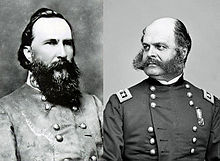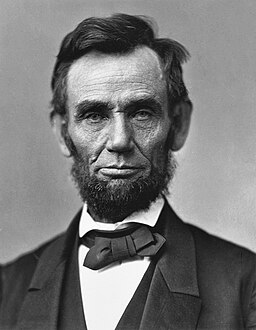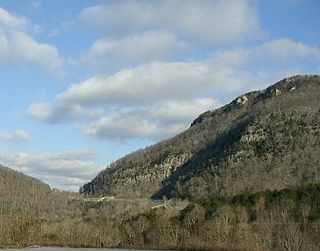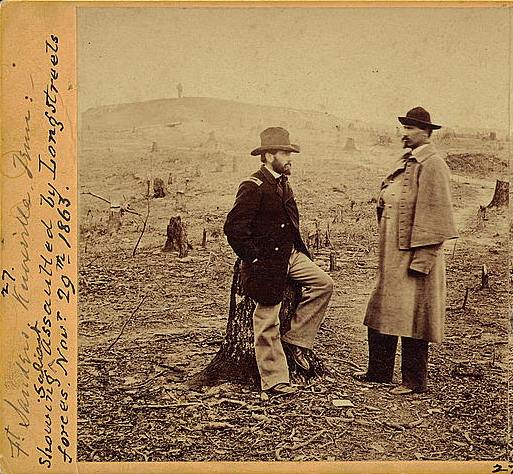
Ambrose Everett Burnside was an American soldier, railroad executive, inventor, industrialist, and politician from Rhode Island. He served as governor and as a United States Senator. As a Union Army general in the American Civil War, he conducted successful campaigns in North Carolina and East Tennessee, as well as countering the raids of Confederate General John Hunt Morgan, but suffered disastrous defeats at the Battle of Fredericksburg and Battle of the Crater. His distinctive style of facial hair became known as sideburns, derived from his last name. He was also the first president of the National Rifle Association.

The Battle of Chickamauga, fought on September 18 – 20, 1863, between U.S. and Confederate forces in the American Civil War, marked the end of a Union offensive in southeastern Tennessee and northwestern Georgia — the Chickamauga Campaign. It was the first major battle of the war fought in Georgia, the most significant Union defeat in the Western Theater, and involved the second-highest number of casualties after the Battle of Gettysburg.
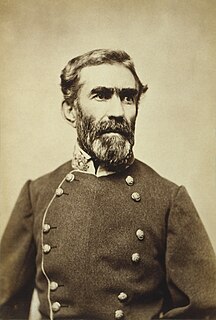
Braxton Bragg was a senior officer of the Confederate States Army who was assigned to duty at Richmond, under direction of the President of the Confederate States of America, Jefferson Davis, and charged with the conduct of military operations of the armies of the Confederate States from February 24, 1864, until January 13, 1865, when he was charged with command and defense of Wilmington, North Carolina. He previously had command of an army in the Western Theater.

The Battle of Lookout Mountain was fought November 24, 1863, as part of the Chattanooga Campaign of the American Civil War. Union forces under Maj. Gen. Joseph Hooker assaulted Lookout Mountain, Chattanooga, Tennessee, and defeated Confederate forces commanded by Maj. Gen. Carter L. Stevenson. Lookout Mountain was one engagement in the Chattanooga battles between Maj. Gen. Ulysses S. Grant's Military Division of the Mississippi and the Confederate Army of Tennessee, commanded by Gen. Braxton Bragg. It drove in the Confederate left flank and allowed Hooker's men to assist in the Battle of Missionary Ridge the following day, which routed Bragg's army, lifting the siege of Union forces in Chattanooga, and opening the gateway into the Deep South.

The Battle of Stones River was a battle fought from December 31, 1862, to January 2, 1863, in Middle Tennessee, as the culmination of the Stones River Campaign in the Western Theater of the American Civil War. Of the major battles of the war, Stones River had the highest percentage of casualties on both sides. Although the battle itself was inconclusive, the Union Army's repulse of two Confederate attacks and the subsequent Confederate withdrawal were a much-needed boost to Union morale after the defeat at the Battle of Fredericksburg, and it dashed Confederate aspirations for control of Middle Tennessee.
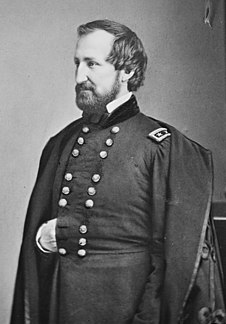
William Starke Rosecrans was an American inventor, coal-oil company executive, diplomat, politician, and U.S. Army officer. He gained fame for his role as a Union general during the American Civil War. He was the victor at prominent Western Theater battles, but his military career was effectively ended following his disastrous defeat at the Battle of Chickamauga in 1863.

The Army of Tennessee was the principal Confederate army operating between the Appalachian Mountains and the Mississippi River during the American Civil War. It was formed in late 1862 and fought until the end of the war in 1865, participating in most of the significant battles in the Western Theater. It should not be confused with the Union Army of the Tennessee, named after the Tennessee River.

The Battle of Missionary Ridge was fought on November 25, 1863, as part of the Chattanooga Campaign of the American Civil War. Following the Union victory in the Battle of Lookout Mountain on November 24, Union forces in the Military Division of the Mississippi under Maj. Gen. Ulysses S. Grant assaulted Missionary Ridge and defeated the Confederate Army of Tennessee, commanded by Gen. Braxton Bragg, forcing it to retreat to Georgia.

The Battle of Fort Sanders was the crucial engagement of the Knoxville Campaign of the American Civil War, fought in Knoxville, Tennessee, on November 29, 1863. Assaults by Confederate Lt. Gen. James Longstreet failed to break through the defensive lines of Union Maj. Gen. Ambrose Burnside, resulting in lopsided casualties, and the Siege of Knoxville entered its final days.
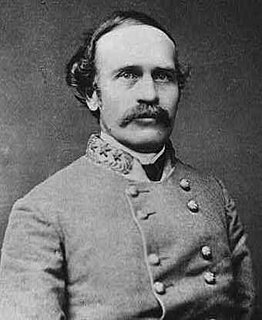
Bushrod Rust Johnson was a Confederate general in the American Civil War and an officer in the United States Army. As a university professor he had been active in the state militias of Kentucky and Tennessee and on the outbreak of hostilities he sided with the South, despite having been born in the North. As a divisional commander he managed to evade capture at the Battle of Fort Donelson, but was wounded at the Battle of Shiloh. He served under Robert E. Lee throughout the 10-month Siege of Petersburg, and surrendered with him at Appomattox.

The Tullahoma Campaign was a military operation conducted from June 24 to July 3, 1863, by the Union Army of the Cumberland under Maj. Gen. William Rosecrans, and regarded as one of the most brilliant maneuvers of the American Civil War. Its effect was to drive the Confederates out of Middle Tennessee and to threaten the strategic city of Chattanooga.

The Battle of Campbell's Station was a battle of the Knoxville Campaign of the American Civil War, occurring on November 16, 1863, at Campbell's Station, Knox County, Tennessee.

The Battle of Wauhatchie was fought October 28–29, 1863, in Hamilton and Marion Counties, Tennessee, and Dade County, Georgia, in the American Civil War. A Union force had seized Brown's Ferry on the Tennessee River, opening a supply line to the Union army in Chattanooga. Confederate forces attempted to dislodge the Union force defending the ferry and again close this supply line but were defeated. Wauhatchie was one of the few night battles of the Civil War.
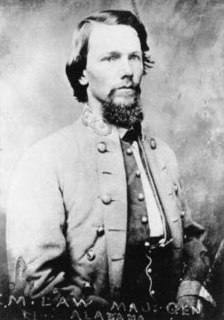
Evander McIver Law was an author, teacher, and a Confederate general in the American Civil War.
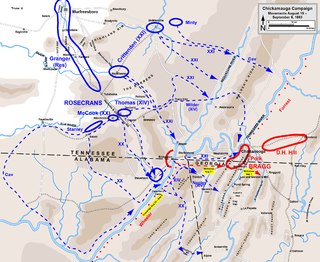
The Chickamauga Campaign of the American Civil War was a series of battles fought in northwestern Georgia from August 21 to September 20, 1863, between the Union Army of the Cumberland and Confederate Army of Tennessee. The campaign started successfully for Union commander William S. Rosecrans, with the Union army occupying the vital city of Chattanooga and forcing the Confederates to retreat into northern Georgia. But a Confederate attack at the Battle of Chickamauga forced Rosecrans to retreat back into Chattanooga and allowed the Confederates to lay siege to the Union forces.

The Western Theater of the American Civil War encompassed major military operations in the states of Alabama, Georgia, Florida, Mississippi, North Carolina, Kentucky, South Carolina and Tennessee, as well as Louisiana east of the Mississippi River. Operations on the coasts of these states, except for Mobile Bay, are considered part of the Lower Seaboard Theater. Most other operations east of the Mississippi are part of the Eastern Theater. Operations west of the Mississippi River took place in the Trans-Mississippi Theater.

John Thomas Wilder was a colonel in the Union Army during the American Civil War, noted principally for capturing a key mountain pass in the Tullahoma Campaign in Central Tennessee in June 1863. Wilder had personally ensured that his 'Lightning Brigade' of mounted infantry would be equipped with the new Spencer repeating rifle, though he initially had to appeal to the rank-and-file to pay for these weapons themselves, before the government agreed to carry the cost. Victory at Hoover's Gap was attributed largely to Wilder's persistence in procuring the new rifles, which totally disoriented the enemy.

The First Corps, Army of Northern Virginia (or Longstreet's Corps) was a military unit fighting for the Confederate States of America in the American Civil War. It was formed in early 1861 and served until the spring of 1865, mostly in the Eastern Theater. The corps was commanded by James Longstreet for most of its existence.
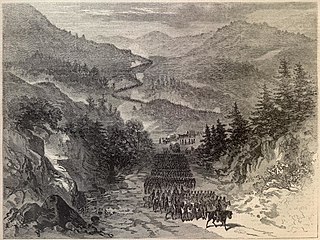
The September 7–9, 1863 fall of the Cumberland Gap was a victory for Union forces under the command of Ambrose Burnside during his campaign for Knoxville. The bloodless engagement cost the Confederates 2,300 men and control of the Cumberland Gap.

The Chattanooga Campaign was a series of maneuvers and battles in October and November 1863, during the American Civil War. Following the defeat of Maj. Gen. William S. Rosecrans' Union Army of the Cumberland at the Battle of Chickamauga in September, the Confederate Army of Tennessee under Gen. Braxton Bragg besieged Rosecrans and his men by occupying key high terrain around Chattanooga, Tennessee. Maj. Gen. Ulysses S. Grant was given command of Union forces in the West, now consolidated under the Division of the Mississippi. Significant reinforcements also began to arrive with him in Chattanooga from Mississippi and the Eastern Theater. On October 19, Grant removed Rosecrans from command of the Army of the Cumberland and replaced him with Major General George Henry Thomas.


